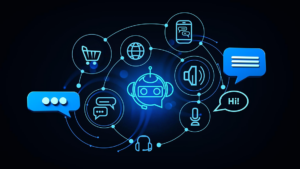
ACL Digital
Unveiling the Power of Generative AI Models in Real-world Problem Solving
In the ever-evolving landscape of artificial intelligence, generative AI models have emerged as commanding tools for undertaking real-world challenges. Such models are capable of creating new data samples that reproduce the characteristics of the training data, and are revolutionizing various industries.
At the core of generative AI lies the ability to generate synthetic data that reproduces the characteristics of the training data. This process involves understanding the underlying distribution of the data and learning to generate new samples that are indistinguishable from real data. By harnessing complex algorithms and neural network architectures, generative AI models have demonstrated remarkable proficiency in creating convincing and realistic data samples.
In this blog, we embark on an exploration of the captivating realm of generative AI, shedding light on its mechanisms, applications in problem-solving, and the promising trends that are shaping its future.
Description of Generative AI Models
Generative AI models are a subset of artificial intelligence systems designed to generate new data samples that resemble the input data they were trained on. Unlike discriminative models, which focus on classification or prediction tasks, generative models are concerned with understanding and generating data distributions. This ability makes them incredibly valuable for real-world problem solving across various industries.
“The market size is expected to show an annual growth rate (CAGR 2024-2030) of 20.80%, resulting in a market volume of US$207.00bn by 2030.” – Statista
To understand how generative AI models contribute to problem-solving, let’s delve deeper into their mechanisms and applications:
Mechanisms of Generative AI Models
Generative AI models operate by learning the underlying patterns and structures of a given dataset and then generating new data that mimics these patterns. These models typically utilize techniques such as variational autoencoders (VAEs), generative adversarial networks (GANs), or autoregressive models. VAEs encode input data into a latent space and then decode it to generate new samples, balancing reconstruction fidelity and variability. GANs consist of a generator that fabricates data and a discriminator that learns to distinguish between real and generated samples, engaging in a min-max game to improve both.
Autoregressive models predict the probability distribution of each element in a sequence conditioned on the previous elements, enabling the generation of coherent sequences. Through training on large datasets, generative AI models capture complex data distributions and produce novel samples with remarkable fidelity and diversity.
Generative Adversarial Networks (GANs)
GANs are composed of two neural networks: a generator and a discriminator. The generator produces synthetic data samples, while the discriminator evaluates whether the samples are real or fake. Through adversarial training, where the generator and discriminator compete against each other, GANs learn to generate high-quality synthetic data that closely resembles the real data.
Variational Autoencoders (VAEs)
VAEs are probabilistic models consisting of an encoder and a decoder. The encoder maps input data to a latent space, where each point represents a potential data sample. The decoder reconstructs data samples from the latent space. VAEs employ variational inference to learn the underlying data distribution and generate new samples by sampling from the learned latent space.
The key components of generative AI models include neural networks, loss functions, and optimization algorithms. Neural networks serve as the backbone of these models, with architectures tailored to specific tasks. Loss functions, such as the adversarial loss in GANs or the reconstruction loss in VAEs, guide the training process by quantifying the difference between generated and real data. Optimization algorithms, such as stochastic gradient descent, are employed to update the model parameters and minimize the loss.
Application of Generative AI in Real-world Problem Solving
Generative AI models are making significant strides in various industries, offering innovative solutions to complex problems. From healthcare and finance to education and manufacturing, these models are revolutionizing how businesses operate, enabling them to automate tasks, generate creative content, optimize processes, and drive insights from vast amounts of data. As the capabilities of Generative AI continue to evolve, its potential to transform industries and reshape the way we work, create, and interact with technology is becoming increasingly evident.
Healthcare
In healthcare, these models are utilized for medical image generation, drug discovery, and patient data generation. For instance, GANs can generate synthetic medical images to augment limited datasets and improve the performance of diagnostic algorithms.
Retail & e-Commerce
Generative AI can be applied to customer segmentation and personalized recommendation systems. By analyzing customer behavior and preferences, retailers can use Generative AI techniques to generate personalized product recommendations tailored to individual shoppers. This not only enhances the relevance of recommendations but also increases the likelihood of repeat purchases and customer loyalty.
Manufacturing
In manufacturing and logistics, generative AI facilitates product design, supply chain optimization, and predictive maintenance. GANs can generate virtual prototypes of products, allowing manufacturers to iterate and refine designs before production. Additionally, VAEs can learn latent representations of complex systems, enabling predictive maintenance based on anomaly detection.
Banking and Finance
In banking and finance, generative models support personalized marketing, credit scoring, and portfolio optimization. By generating synthetic customer profiles, these models enable banks to tailor their marketing strategies and offer personalized financial products. Moreover, VAEs can learn the surrounding of financial data, facilitating accurate credit risk assessment and portfolio management. Generative models are employed for fraud detection, risk assessment, and algorithmic trading. By generating synthetic financial data, these models enable organizations to train robust fraud detection systems and identify anomalies in transactions.
Education
One significant application is in the creation of personalized learning materials. Generative AI algorithms can generate customized educational content tailored to individual student needs, preferences, and learning styles. By analyzing student performance data and curriculum requirements, Generative AI can generate interactive exercises, quizzes, and tutorials that adapt to each student’s pace and level of understanding, thereby fostering more effective learning outcomes.
Exploring Upcoming Trends in Generative Models
As generative AI continues to advance, several emerging trends are shaping the future of these models. One trend is the integration of generative models with reinforcement learning, enabling agents to interact with their environment and generate data in a more interactive and dynamic manner.
There is growing interest in the ethical implications of generative AI, including issues related to bias, fairness, and privacy. Researchers and practitioners are actively working towards developing responsible AI systems that mitigate these concerns.
Generative AI models are ushering in a new era of problem-solving, offering unprecedented capabilities across diverse domains. From healthcare to finance, manufacturing to banking, these models are revolutionizing industries and driving innovation. As we continue to push the boundaries of generative AI, the possibilities for real-world applications are limitless. By harnessing the power of generative models, we can address complex challenges and pave the way for a brighter future.
Upcoming trends in generative models unveil a landscape rich with innovation and promise. These models, which generate new data instances that resemble a given dataset, are becoming increasingly prominent across various domains, from computer vision and natural language processing to drug discovery and art generation. Two prominent types of generative models, Generative Adversarial Networks (GANs) and Variational Autoencoders (VAEs), have garnered significant attention for their ability to generate realistic images, videos, and text.
Generative models have undergone significant advancements recently, leading to emerging trends and opportunities in many ways. One such trend is the exploration of few-shot learning, where models are trained to generate high-quality samples with minimal training data. This capability holds immense potential for applications requiring limited data availability, such as personalized medicine and rare event prediction.
Another emerging trend is the rise of self-supervised learning techniques in generative modeling. By leveraging unlabeled data to learn meaningful representations, self-supervised learning enables generative models to capture complex patterns and structures in the data more effectively. This approach has the potential to enhance the generalization and robustness of generative models across various tasks and domains.
Multimodal generation, which involves generating data across multiple modalities such as text, images, and audio simultaneously, is gaining traction as a promising research direction. By enabling generative models to understand and synthesize diverse types of data, multimodal generation opens up new possibilities for applications like content creation, human-computer interaction, and immersive experiences.
As researchers and practitioners continue to push the boundaries of generative modeling, we can expect to see further advancements in model architectures, training techniques, and application domains. These trends not only promise to unlock new capabilities and functionalities but also to democratize access to generative modeling tools and empower users across industries to create, innovate, and explore new frontiers in artificial intelligence. If you want to know more about advancements in generative AI, keep exploring our blogs.
Related Insights

From DevOps to DevSecOps: Strengthening Security without Slowing Innovation

How multimodal interactions enhance the experience of commerce

AI-Powered Applications with AWS SageMaker: Accelerating ML Model Training and Deployment
How Semiconductors Power the Future of Smart Home Technology



